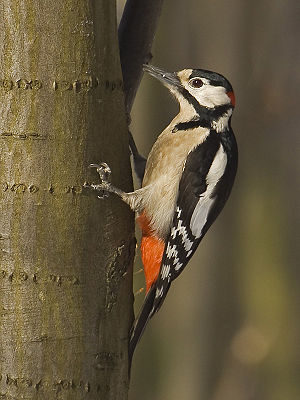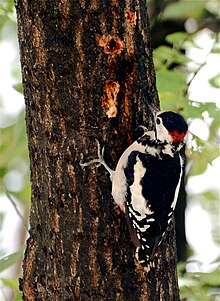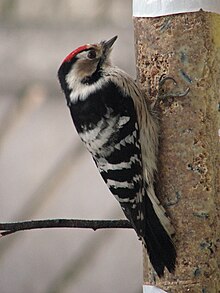great spotted woodpecker
| great spotted woodpecker | ||||||||||
|---|---|---|---|---|---|---|---|---|---|---|

Great Spotted Woodpecker ♂ The great spotted woodpecker's |
||||||||||
| Systematics | ||||||||||
|
||||||||||
| Scientific name | ||||||||||
| Dendrocopos major | ||||||||||
| ( Linnaeus , 1758) |
The great spotted woodpecker ( Dendrocopos major , Syn. : Picoides major ) is a bird from the family of woodpeckers (Picidae). The little woodpecker inhabits large parts of northern Eurasia and North Africa and inhabits forests of almost every kind as well as parks and tree-lined gardens. Food is sought in all strata of the forest (with the exception of the forest floor), but mainly in the treetops. It consists of both animal parts and, especially in winter, of plant material. The food spectrum is very broad and includes a wide variety of insects and other invertebrates as well as small vertebrates and bird eggs, seeds, berries and other fruits as well as tree saps.
The species is common and the population is increasing, at least in Europe. The great spotted woodpecker is therefore classified by the IUCN as safe (“least concern”).
Appearance
The great spotted woodpecker is about 23 centimeters tall. Its wingspan is between 34 and 39 centimeters. It weighs between 60 and 90 grams. Its plumage is black on top with two large white wing spots and yellowish-gray on the underside. The under tail-coverts are colored bright red. Only the male has a red spot on the neck and young animals have a red crown. The cheeks are colored white. There are black beard stripes on the sides of the neck.
The great spotted woodpeckers have pointed, curved claws on their climbing feet, which they use to hold on to the bark. Two claws point to the front and two to the back. Their skin, which protects them from insect bites, is unusually thick. A resilient, joint-like connection between the broad base of the beak and the skull cushions the shock that occurs when the woodpecker cave is carved out. The upright and stable posture on the tree is supported by strong muscles that control the supporting tail feathers. In order to prevent inhalation of the resulting wood flour, the nostrils of the great spotted woodpecker are overgrown with fine feathers.
Visually similar and therefore easy to confuse with the great spotted woodpecker in Central Europe are the medium-sized woodpecker , the small woodpecker , the white-backed woodpecker and the blood-pecked woodpecker , all of which are much less common in Germany.
distribution
The great spotted woodpecker occurs in Europe as well as in North and East Asia . Adjacent to the European area, there are also occurrences in Northwest Africa ( Atlas countries) and in Southwest Asia ( Anatolia , Caucasus countries, North Iran ). In Central Europe it is a resident bird , in the north it is occasionally also a barbed bird .
habitat
The great spotted woodpecker is the least specialized native woodpecker and therefore also the most common. It can be found in both deciduous and coniferous forests , but also in parks and in the cultivated landscape , provided there are avenues , windbreaks or small groups of trees. Mixed oak and beech forests with a lot of old and dead wood are ideal habitats for him . Monotonous spruce pure stocks have only low Specht deposits.
nutrition
For most of the year, the great spotted woodpecker feeds mainly on insects and their larvae , which it fetches from under the bark with powerful beak blows. During the winter he is able to change his diet. During this time when insects are scarce, he eats nuts , berries and seeds . Many of the high-fat seeds that feed it in winter have to be cracked first. While corvids , such as the jay , hold hazelnuts with their feet, the great spotted woodpecker jams nuts or pine cones in the cracks of a tree. To obtain the latter, he often hacks a hole in a branch in order to clamp the tenon in it. These are the so-called woodpecker smiths , which the great spotted woodpecker also uses to crack hard-shelled beetles. If the great spotted woodpecker has found a new usable cone, it flies to its "smithy" and holds the new cone in the chest / torso area while it first has to remove the old cone. Then the new cone is pushed into the gap that serves as the "anvil" and then gradually chopped up in order to pick up the seeds with the tongue. As a further herbal food supplement, the great spotted woodpecker licks sap on marigold trees , especially in spring . Insects attracted by the sap are also absorbed. In winter you can sometimes see the great spotted woodpecker at bird feeders. They can also sometimes be seen on tit balls.
Great spotted woodpeckers sometimes appear as nest robbers and open the nesting holes of titmouse or small woodpecker.
Vocalizations
The “drumming”, a very fast sequence of 10 to 15 beak beats lasting up to 2 seconds, serves to attract the females during courtship and to define the territory. The drumming can be heard as early as the end of winter. The males start drumming as soon as the cave they have built is ready for occupancy, using all available sound boxes . Hollow tree trunks or dead branches are typical. However, great spotted woodpeckers also let their eddies ring out on gutters. While individual drum rolls, which only consist of 10 to 20 individual beats, sound all year round, the male drum rolls are longer and sound more frequently during the courtship season from December onwards. The females also let drum rolls sound when they are in the territory of a male and thus draw attention to themselves. The courtship also contains threatening gestures such as tearing open the beak or setting up the crown feathers.
Another utterance is a short, hard “kick” or “kix”.
Reproduction
Like all woodpeckers, the great spotted woodpecker is a cave breeder . He builds the breeding caves himself and prefers soft types of wood and rotten old trees. He begins to work out many cavities before completing a single one.
It lays four to seven white eggs , which are incubated for about 11-13 days. The young birds are fed for about three to four weeks before they fly out. In the second half of the feeding phase , the nests are easy to spot because of the continuous loud nagging of the young birds.
Up to 20% of the females live in polyandry . Older experienced females begin a first brood with an older experienced male. A second brood then follows with a mostly younger male. The female takes part in the breeding, hatching and mating phases of both broods. Later she leaves the rearing of the second brood to the male of the second brood.
Others
The great spotted woodpecker was bird of the year in Germany in 1997 and bird of the year in Switzerland in 2016 .
Great spotted woodpeckers can cause woodpecker damage when they build burrows in the insulation of buildings.
Subspecies
Twenty-four subspecies are known:
- Dendrocopos major major ( Linnaeus , 1758) occurs in Scandinavia and the northeast of Poland to western Siberia .
- Dendrocopos major brevirostris ( Reichenbach , 1854) is distributed in western Siberia via eastern Siberia, north-east China and north Mongolia .
- Dendrocopos major kamtschaticus ( Dybowski , 1883) occurs on the Kamchatka Peninsula.
- Dendrocopos major anglicus Hartert , 1900 is common in Great Britain .
- Dendrocopos major pinetorum ( Brehm, CL , 1831) occurs in Central Europe.
- Dendrocopos major parroti Hartert , 1911 occurs in Corsica .
- Dendrocopos major harterti Arrigoni degli Oddi , 1902 is common in Sardinia .
- Dendrocopos major italiae ( Stresemann , 1919) is common in Italy , Sicily and western Slovenia .
- Dendrocopos major hispanus ( Schlueter , 1908) occurs on the Iberian Peninsula .
- Dendrocopos major canariensis ( Koenig, AF , 1889) occurs in Tenerife .
- Dendrocopos major thanneri le Roi , 1911 is common in Gran Canaria .
- Dendrocopos major mauritanus ( Brehm, CL , 1855) is distributed in Morocco .
- Dendrocopos major numidus ( Malherbe , 1843) occurs in northern Algeria and Tunisia .
- Dendrocopos major candidus ( Stresemann , 1919) occurs from Romania and southern Ukraine to Greece .
- Dendrocopos major paphlagoniae ( Kummerlöwe & Niethammer , 1935) is common in northern Turkey .
- Dendrocopos major tenuirostris Buturlin , 1906 occurs in the Caucasus and South Caucasus .
- Dendrocopos major poelzami ( Bogdanov , 1879) is common in southeastern Azerbaijan , northern Iran, and southwestern Turkmenistan .
- Dendrocopos major japonicus ( Seebohm , 1883) occurs in southeast Siberia, northeast China, Korea, and northern and central Japan .
- Dendrocopos major wulashanicus Cheng , Xian , Zhang, Y & Jiang , 1975 Inner Mongolia (n China)
- Dendrocopos major cabanisi ( Malherbe , 1854) occurs in eastern China.
- Dendrocopos major beicki ( Stresemann , 1927) occurs in central China.
- Dendrocopos major mandarinus ( Malherbe , 1857) is distributed in southern China and eastern Myanmar via northern Laos to northern Vietnam .
- Dendrocopos major stresemanni ( Rensch , 1923) occurs in northeastern India , northeastern Myanmar over southeastern Tibet and southern central China in the provinces of Sichuan and Yunnan .
- Dendrocopos major hainanus Hartert & Hesse , 1911 occurs on Hainan .
| Similar species | ||
|---|---|---|
| great spotted woodpecker | Middle woodpecker | Small woodpecker |
|
|
|
literature
- Dieter Blume , Jens Tiefenbach: The great spotted woodpeckers. Genus Picoides. (= Die Neue Brehm-Bücherei. Volume 315). 4th edition. Westarp Wissenschaften-Verlagsgesellschaft mbH, Hohenwarsleben 1997, ISBN 3-89432-732-4 .
- Hans Winkler , David A. Christie , David Nurney : Woodpeckers. A Guide to the Woodpeckers, Piculets, and Wrynecks of the World. Pica Press, Robertsbridge 1995, ISBN 0-395-72043-5 , pp. 98-99 and 273-276.
Individual evidence
- ↑ Heiko Schumacher: On the influence of forest management on the avifauna of red beech forests in the northeast German lowlands . Dissertation University of Göttingen 2006. Cuvillier, Göttingen 2006. 179 (XXXII) S., ISBN 3-86537-745-9 , Appendix 3.
- ^ S. Cramp: Handbook of the birds of Europe, the Middle East, and North Africa, vol. 4 . Oxford University Press. Oxford NY 1985.
- ↑ What do great spotted woodpeckers eat? , on blog.canoncam.de
- ↑ Rolf Hennes: Population dynamics of a facultative polyandric population of the Butspechtes Dendrocops major. Charadrius 53/2017: 48-50
- ↑ Bird of the Year 1997 , on nabu.de
- ↑ Bird of the year 2016: Great Spotted Woodpecker, on birdlife.ch
- ^ IOC World Bird List Woodpeckers (English), on worldbirdnames.org
Web links
- NABU: The great spotted woodpecker is bird of the year 1997
- Dendrocopos major in the Red List of Threatened Species of the IUCN 2010. Posted by: BirdLife International, 2009. Retrieved on February 2, 2011th
- Videos, photos and sound recordings on Dendrocopos major in the Internet Bird Collection
- Age and gender characteristics (PDF; 5.3 MB) by J. Blasco-Zumeta and G.-M. Heinze (Eng.)
- Great spotted woodpecker's feathers










